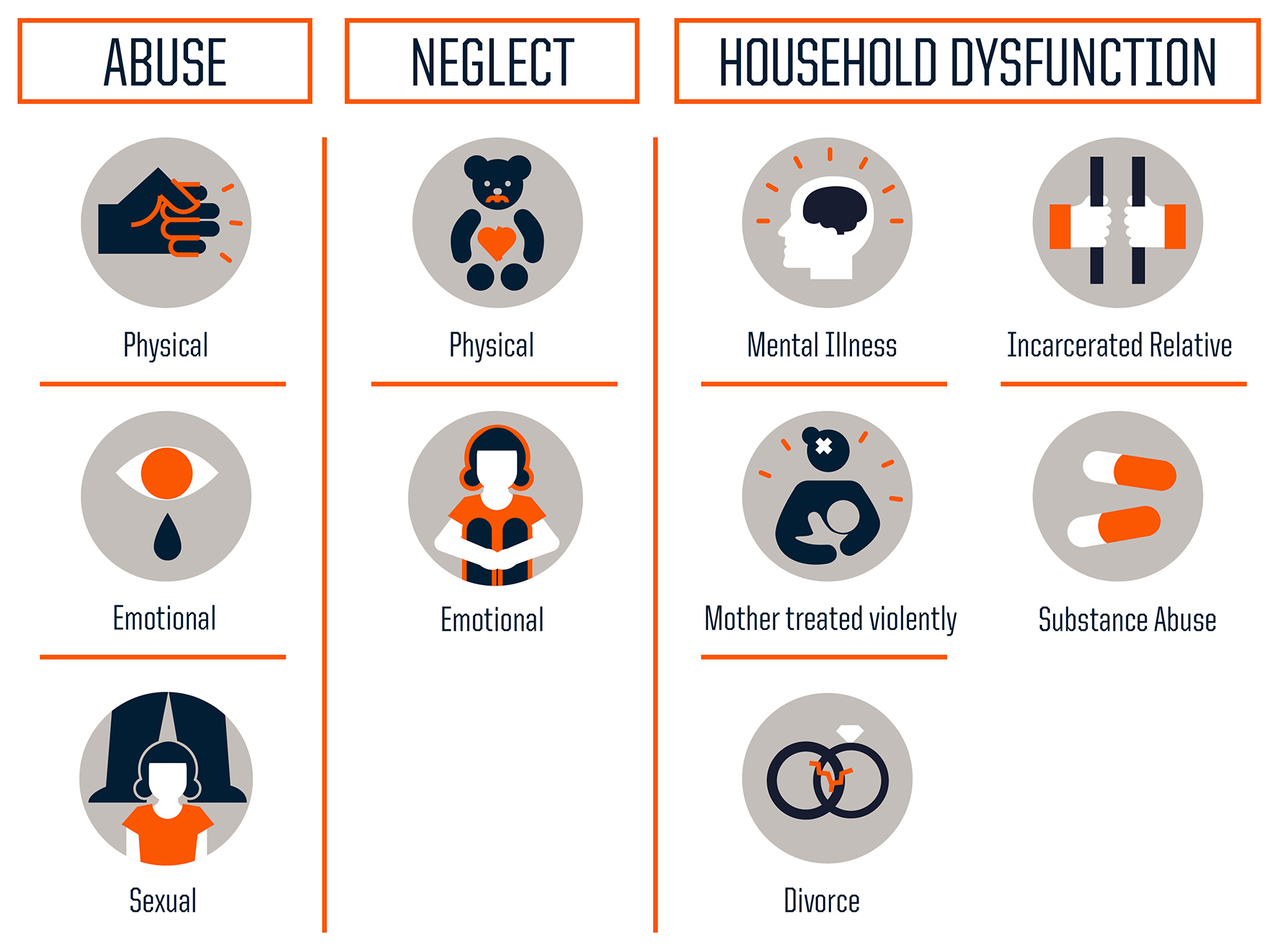This is one of my favorite subjects. It is so damn fascinating to me. Did you know that trauma can literally affect the structure of the brain? It can reduce activity in one area and increase activity in another area. It can prevent neurological pathways from forming or connecting. Trauma changes the shape and structure and function of certain areas of the brain, which in turn causes mental, behavioral, and physical health issues. Let me show you what I mean.
ACEs
There have been numerous studies on these things called ACEs, or Adverse Childhood Experiences. ACEs fall under 3 categories: abuse (physical, emotional, or sexual), neglect (physical or emotional), and household dysfunction (mental illness, domestic violence, substance abuse, incarceration, or divorce). Studies have shown a direct correlation between ACEs and future health problems in individuals. More ACEs = more toxic stress = higher impact to the structure of the brain. And according to the CDC, 2 in 3 children have experienced and Adverse Childhood Event. 2 IN 3!

Credit: Robert Wood Johnson Foundation
Brain Imaging
So how does this affect the brain? What does that look like? The image on the left is of a healthy 3-yr-old boy. There is a lot of activity, especially in the front of the brain – the part that is able to think rationally, make decisions, and think about consequences (as best as a 3-yr-old can). The image on the right is of a 3-yr-old who has experienced prolonged abuse and neglect. There is MUCH less activity in the brain, and the part that has the most activity is toward the back – the part that is responsible for survival. The traumatized brain is underdeveloped. There are neurons that have not connected, parts that have not been activated. The basic structure and architecture of the brain is different. This child may have never learned how to communicate, how to correctly perceive threats, how to regulate emotions, etc.
Brain Structure
The brain is its own little universe and neurobiologists are constantly learning more and more about it. There are things we thought we knew that have changed and there is still uncharted territory, but I’m going to do my best to give a quick rundown of some of the structures of our brain, what those structures do, and how toxic stress affects them. Stick with me.
The main areas of the brain impacted by trauma are the amygdala, hippocampus, and prefrontal cortex.
The amygdala is our body’s alarm system. It’s a tiny almond-shaped structure in our brain that is responsible for recognizing the threat of danger and alerting our body to get ready to fight, flee, or freeze. The amygdala is not necessarily “smart”, meaning that it can’t tell the difference between, say, public speaking and being approached by a mountain lion. It just recognizes fear and triggers the stress response in our bodies, getting us ready do what we need to survive. Still with me?
The hippocampus is responsible for memory, which is why people who are diagnosed with PTSD have memory-related difficulties. They may not remember details about the trauma, or intrusive images of their trauma pop up uninvited. (Just as an aside, there are direct connections established by the olfactory bulb and olfactory cortex on both the amygdala and hippocampus, meaning that smells are directly connected to our memory and emotional response. That’s why if your dad drank Jack Daniels and became abusive, the smell of Jack Daniels will likely make you sick well into adulthood. Fascinating, yes?)
The prefrontal cortex plays a huge role in our personalities. It’s responsible for planning, decision making, impulse control, focusing, and emotional control. First of all, this area is not even close to being fully formed until we’re in our 20s, and then it continues to be shaped and to grow even after that. So if you see your kid do something stupid, or if you wonder why teenagers don’t have common sense, it’s actually pretty developmentally appropriate. The common sense area in their brains isn’t fully formed yet (and some people’s never are). Now imagine this child with the prefrontal cortex that isn’t fully formed experiencing trauma. It’s like a double whammy to their ability to think things through and make logical, rational choices.
No Wonder
So, if trauma affects the parts of our brain that control fear response and anxiety, memory, the ability to understand consequences, focus, and decision making, then no wonder. No wonder we see kids with more behavioral issues and more mental health diagnoses than ever. No wonder 1 in 4 children is diagnosed with a mental health challenge. No wonder 50% of students in classrooms struggle with trauma or a mental health diagnosis or are socially/emotionally delayed. No wonder these kids turn into adults with anxiety, depression, substance abuse addictions, physical health problems, and relationship issues.
This is important to know because often children who present with certain symptoms – anger, anxiety, hyperactivity, etc. – are misdiagnosed. They are slapped with an ADHD diagnosis when they are really struggling with anxiety. They are labeled as the “bad kid” when really their behavior is an effect of toxic stress and trauma from their past. They are angry because they are hardwired for survival mode. They are anxious because they constantly feel like they are in danger. They are hyper because their brain is getting their bodies ready to fight or flee. There is no actual threat, but their brains are hardwired to see everything as a threat.
Parents, teachers, foster parents, caregivers, ANY adult who interacts with kids: If there is a child who seems flat-out “bad”, often it is because of past trauma. Reframe your thoughts from “What’s wrong with you?” to “What happened to you?” They may literally not have the capacity to think rationally at times – especially when they are upset. (FYI: Foster kids have always experienced toxic stress, or they wouldn’t be in foster care.)
Resilience
The good news is that our brains constantly grow and change, and neurons can be re-activated. How do we help children overcome trauma? By building resilience. Joining Forces for Children lists seven core ideas to help develop and foster resilience in children:
- Competence – Building their understanding of their skills.
- Confidence – Helping kids grow a true belief in their own abilities.
- Connection – Connecting children with other people, schools and communities to further build their support system.
- Character – Helping them comprehend a clear sense of right and wrong, and teaching them moral values.
- Contribution – Offering children a chance to contribute to the well-being of others. They learn that giving service feels good and then feel more confident to ask others for help as well.
- Coping – Discovering a variety of healthy coping strategies to prevent children from dangerous “quick fixes” to stress.
- Control – Teaching children to make decisions on their own so they can experience a sense of control.
Another way to help build resilience is to help children increase their emotional intelligence. Help them learn the names of emotions and how they are applied. This builds empathy and also gives them a sense of control over the emotion. Imagine how frustrating it is for a child to feel frustrated and not know the word “frustrated”. Help them name the emotion so they can tame the emotion.
It’s such a relief to know that kids who have experienced trauma can build resiliency and, in turn, restructure their brain through positive experiences and relationships. Be that person for a kid. Be kind to children and teenagers, especially the ones who are the hardest to be kind to. It can be the difference between surviving and thriving. It can change lives.







